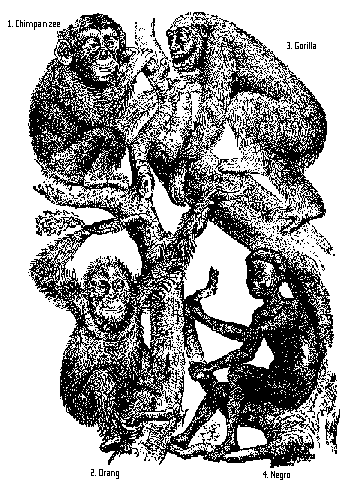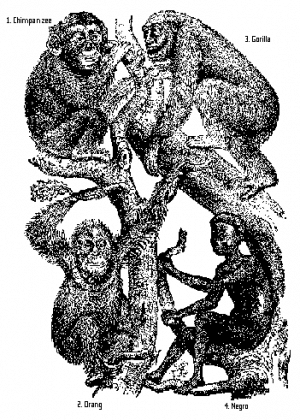Haeckel: The Legacy of a Lie
Haeckel: The Legacy of a Lie
Although books on evolution began refuting Haeckel’s biogenetic “law” in the 1920s, his idealized drawings of embryos with gill-slits, and his mantra-like saying, “ontogeny recapitulates phylogeny,” became part of evolutionary folklore [see feature article]. Biology textbooks perpetuated this fable well into the second half of the twentieth century.
Modern editions rarely present the latest evolutionary ideas on embryology and remain content to rest their case on century-old woodcuts and misnamed “gill slits.” Such imagery persists in the popular media, too. When USA Today published an article on genetic similarities as proof for evolution, the author’s analogy and sole illustration invoked the icons of comparative embryology (Friend, 1993).
Not only were Haeckel’s ideas persistent, but they were also pernicious. He used his position as professor of zoology at the University of Jena to convert German science and Germany to Darwinism. Haeckel’s efforts outstripped the zeal of Thomas H. Huxley, “Darwin’s bulldog” in England. Like Huxley, however, he took Darwin’s theory beyond the confines of biological origins into politics, religion, and other social concerns. Under the guise of evolutionary science, Haeckel and Huxley hoped to rescue humanity from what was, in their opinion, the destructive ignorance of religious delusion.
Haeckel’s embryonic recapitulation inspired a host of popular, but false, conceptions. Perhaps the most powerful offshoot was a rationalization for scientific racism. If it could be shown that the white races are more evolved (read “advanced”) than the dark races, then slavery and colonialism were permissible, even necessary. While Darwin’s work suggested such conclusions, or at least provided the language for making such claims, Haeckel’s ideas could be grasped by ready observation. If the human embryo retraces its animal ancestry, culminating in a fully human child, then the child retraces its human ancestry, culminating in the supreme adult form.
To many scientists of the nineteenth and early twentieth centuries, the candidate for that most evolved state was obvious: the northern European white male—a category they happened to occupy. In contrast, the dusky inhabitants of Africa and Asia were simple, more child-like, and hence, less deserving of equal treatment and self-rule. As Gould noted: “If the conquest of distant lands upset some Christian beliefs, science could always relieve a bothered conscience by pointing out that primitive people, like white children, were incapable of self-government in a modern world” (1977, p. 218).
The evolutionary racists amassed a wealth of data, based on convenient physical and behavioral criteria, to prove their point. They applied the same contorted reasoning and conclusions to women and anybody who, by their standards, exhibited child-like characteristics.

“African Man-like Apes black in colour, and like their countrymen, the Negroes, have the head long from back to front…. The Asiatic Man-like Apes are, on the contrary mostly brown, or yellowish-brown colour, and have the head short from front to back…, like their countrymen, the Malays and the Monogols” (Haeckel, 1876, 2:180-181).
Haeckel himself was an unabashed racist. He urged the German people to seek racial purity by purging the unfit among them, and to increase the superiority of the “Nordic race” by violent competition (i.e., war) with other nations. A few decades later, these ideas found fertile soil in Adolf Hitler’s mind, and were openly expressed in his book Mein Kampf, or in English, “My Struggle” (taken from Haeckel’s translation of Darwin’s phrase, “the struggle for existence”).
The myth of recapitulation also provided the basis for Freudian psychoanalysis. Freud developed the idea that neurotic adults were stuck in an earlier stage of human evolutionary history. Further, he believed that contemporary “primitive” cultures provided a fitting analogy for the distant past of “advanced” Europeans. In the opening paragraphs of Totem and Taboo, Freud wrote:
Primitive man is known to us by the stages of development through which he has passed…. We can thus judge the so-called savage and semi-savage races; their psychic life assumes a peculiar interest for us, for we can recognize in their psychic life a well-preserved, early stage of our own development (1938, p. 807).
He went on to argue that taboos against incest arose from incidents in Stone Age societies in which sons murdered their fathers so that they could mate with their mothers. Hence, Freud hoped to understand dysfunctional behavior in the light of our supposed primitive past. One of the many problems with this idea is that it simply was not true: nonindustrial cultures do not have a high incidence of patricide and a lack of incest taboos, and anthropologists have not found evidence for Freud’s ideas in ancient cultures (see Milner, 1990, pp. 176-178; Bower, 1991).
Finally, to show how Haeckel’s views surfaced in the 1990s, we can turn to one of the great popularizers of evolution, Carl Sagan. In a Parade Magazine article, Sagan (and co-author Ann Druyan) use the following terms to describe the developmental stages of the pre-born human: “a kind of parasite,” “a little like a segmented worm,” “something like the gill arches of a fish or amphibian,” “the reptilian face,” “somewhat pig-like,” “resembles that of a primate” and, eventually, “recognizably human.” Although they never mention Haeckel’s name, their point is clear: abortion in the first few months of pregnancy is acceptable because the embryo or fetus is a lower form of life during this period (see Jackson, 1990; Ham, 1992).
The abuses of embryonic recapitulation do not, by themselves, disprove Haeckel’s theory. However, it was literally too good to be true for many groups who needed a crutch for their own false theories. Haeckel was determined to give Darwinism a proof its critics could not assail and so, at the very outset, his motives hardly epitomized calm, objective science. By exaggerating the appearance of similarity, and tying it to a radical philosophical view, Haeckel sanctioned the ensuing abuses. It seems his legacy, and a need for response on our part, will continue well into the twenty-first century.
REFERENCES
Bower, Bruce (1991), “Oedipus Wrecked,” Science News, 140:248-249, October 19.
Freud, Sigmund (1938), “Totem and Taboo,” The Basic Writings of Sigmund Freud (New York: Random House, edited and translated by A.A. Brill), pp. 807-930.
Friend, Tim (1993), “Clues to Human Development Float in Nature’s Gene Pool,” USA Today, p. 5-D, July 27.
Gould, Stephen Jay (1977), “Racism and Recapitulation,” Ever Since Darwin (New York: W.W. Norton).
Haeckel, Ernst (1876), The Evolution of Man (Akron, OH: Werner, English translation of third edition).
Ham, Ken (1992), “The Smartest Man in America?,” Back to Genesis, [a pamphlet] (El Cajon, CA: Institute for Creation Research), No. 48.
Jackson, Wayne (1990), “Evolution & Abortion: A Fatal Connection,” Christian Courier, 26:13, August.
Milner, Richard (1990), The Encyclopedia of Evolution (New York: Facts on File).

REPRODUCTION & DISCLAIMERS: We are happy to grant permission for this article to be reproduced in part or in its entirety, as long as our stipulations are observed.



0 Comments:
Post a Comment
<< Home